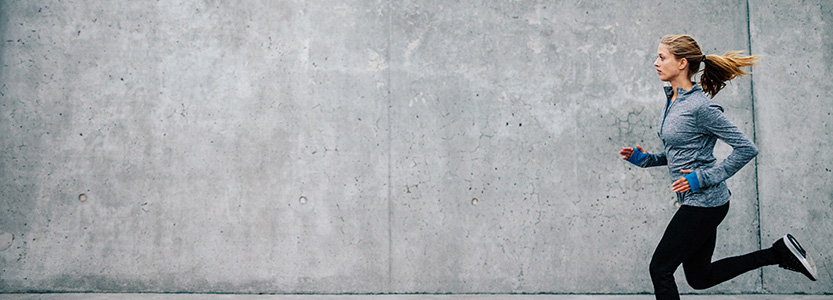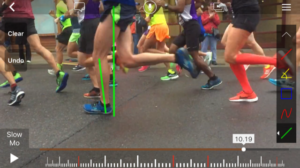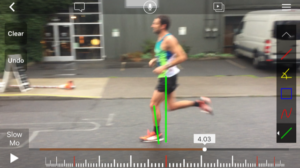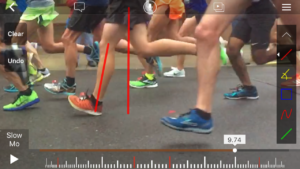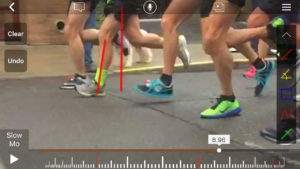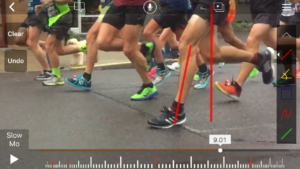The What and Why of Cadence
What Is Cadence?
- the beat, rate, or measure of any rhythmic movement
- the flow or rhythm of events, especially the pattern in which something is experienced
- (in gait)…the number of steps per minute
As a runner, you’ve likely been asked, “What’s your cadence?” or “What’s your stride rate?” or “How many steps per minute do you take?”
Does it matter? Yes. And no.
Stride rate is one variable in a complex – or fundamental components of the running gait cycle that we ostensibly make complex – equation for efficient and injury reduction running. Injury reduction? Not prevention? At Rose City Physical Therapy we don’t endorse the promotion of “injury prevention” running programs. Ask a coach, a performance specialist or a physical therapist to guarantee you that their program will prevent you from getting injured and I wager not one will make such a guarantee. Injury is common in runners and the rates are high. If you run, at some point you have likely experienced or will eventually contend with an injury. A systematic review by van Gent and others reports that average running injury rates vary between 19.4% and 92.4% per year with an approximate 50% average (British Journal of Sports Medicine. 2007). Vidabek and others in another more recent systematic review and meta-analysis reported an incidence of 2.5 injuries per 1000 hours of running in accomplished long-distance track athletes to a maximum of 33.0 injuries per 1000 hours in a study of novice runners (Sports Medicine. 2015). The point is, runners get injured.
Popularized by running coach Jack Daniels while observing runners at the 1984 Los Angeles Olympic summer games, it was reported that all runners, regardless of sex or height, took between ”180 steps or more per minute”. From his statement, the ‘magical 180’ was inferred and people have taken that to mean all elite runners run at 180 steps per minute (spm). This in fact is not what Daniel’s stated. He actually reported some of the runner’s cadence was as high as 200 spm.
In lieu of overcomplicating cadence, I’ll simplify what we know and why cadence has relevance to the runner. Speed = Stride length x Stride rate.
In lieu of overcomplicating cadence, I’ll simplify what we know and why cadence has relevance to the runner. Speed = Stride length x Stride rate. Therefore, to run faster you can either increase your stride length or your stride rate. Height clearly influences this equation also; however, this is a constant variable so I’ll forego that. Most recreational, non-elite or improperly coached runners increase their speed by increasing their stride length on the front side – meaning they over stride. And runners who over stride take fewer steps per minute than those who do not over stride and their foot is in contact with the ground for a longer duration as well. In other words, they have a lower stride rate – and research suggests a stride rate of 162 spm or less has a direct correlation to incidence of injury.
Over striding is like slamming on the brakes when driving.
Over striding is like slamming on the brakes when driving. The foot contacts the ground well in front of 1) the body’s center of mass and 2) a plumb line dropped down from the knee to the ground (i.e. in front of the knee) at point of initial foot contact. This initial contact can occur at the heel, the rear-foot, the mid-foot or the forefoot. With foot contact occurring well out in front of your center of mass, in addition to the initial braking that occurs and slows you down, you also have to get your body over that contact point and prepare for push off. This creates excessive ground reaction (impact) force, vertical displacement of your body (think bouncy running) and places undue stress on your bones and joints. It just so happens the most common contact pattern in over striders is heel striking. Larsen and others reported an incidence of heel striking at the 10km mark in a half-marathon/marathon race of 88.9% with a greater prevalence in the recreational distance runners versus the seasoned runners (Journal of Sports Science. 2011). Another study be Kasmer and others observed a 93.67% prevalence of heel striking in 1991 runners observed during a marathon (International Journal Sports Physiological Performance 2013).
Studies suggest the problem is not what part of your foot touches the ground first, but how close the initial contact is – or is not – underneath your hips, i.e. your center of mass.
We’ve been led to believe that heel striking is bad. But is it? Studies suggest the problem is not what part of your foot touches the ground first, but how close the initial contact is – or is not – underneath your hips, i.e. your center of mass – illustrated in Figures 1 and 2 below.
Figures 1 and 2 illustrate appropriate initial contact close to under the runner’s hip (center of mass) as illustrated by the minimal open space between the initial foot contact and the vertical green line dropped down from the hip; Figure 1 via rear-foot contact and Figure 2 via mid-foot contact. Notice each runner’s initial foot contact is also behind the flexed (bent) knee as exemplified by the tibia (lower leg bone) being appropriately declined backward of vertical – illustrated by the green line overlaying the tibia from the knee to the ankle.
No research has reported that the heel striker is at more risk of injury than the non-heel striker as long as the initial contact occurs in a non-over stride position. It just so happens that with over striding no matter what part of your foot contacts the ground first it occurs with a knee that is straight and locked out (Figure 3), or near straight (Figures 4 and 5) – illustrated by the red line overlaying the tibia from the knee to the ankle. Notice this line is declined forward of a vertical tibia orientation. Also notice the initial foot contact occurs well forward of the runner’s center of mass – illustrated by the large open space between initial foot contact and the vertical red line dropped down from the hip.
The main purpose of manipulating cadence is to prevent over striding. As previously stated, most recreational runners over stride. And a cadence of 162 spm or lower is common in those who over stride. If you don’t over stride, manipulating cadence is likely unnecessary.
Recreational and ‘weekend warrior’ runners commonly run between 150 and 170 steps per minute, while seasoned runners commonly run around 180spm or higher. ‘Commonly’ is the key word here, as there exists a broad range amongst runners. Recently, while watching the 2017 IAAF World Track and Field Championships occurring in London, I decide to count the cadence of several athletes in various events. Here’s what I found:
| Athlete | Event | Cadence (via visual count) | Approximate, Point in event |
| Mo Farah | Men’s 10,000 meter…1st place finish | 168 spm | 3200 meter mark |
| “ “ “ | “ “ “ “ | 168 spm | 9000 meter mark |
| “ “ “ | “ “ “ “ | 192 spm | home stretch |
| Joshua Cheptegei | Men’s 10,000 meter…2nd place finish | 180 spm | 3400 meter mark |
| “ “ “ | “ “ “ “ | 192 spm | 9800 meter mark |
| Abadi Hadis | Men’s 10,000 meter…7th place finish | 180 spm | 5700 meter mark |
| Almaz Ayana | Women’s 10,000 meter…1st place finish | 180 spm | 4800 meter mark |
| “ “ “ | “ “ “ “ | 192 spm | 5200 meter mark |
| “ “ “ | “ “ “ “ | 184 spm | 7000 meter mark |
| “ “ “ | “ “ “ “ | 198 spm | home stretch |
| “ “ “ | Women’s 5,000 meter finals…2nd place finish | 180 spm | 3300 meter mark |
| Tirunesh Dibaba | Women’s 10,000 meter…2nd place finish | 168 spm | 6800 meter mark |
| “ “ “ | “ “ “ “ | 186 spm | 8200 meter mark |
| “ “ “ | “ “ “ “ | 228 spm | home stretch |
| Agnes Jebet Tirop | Women’s 10,000 meter…3rd place finish | 192 spm | 9800 meter mark |
| “ “ “ | “ “ “ “ | 204 spm | home stretch |
| Hyvin Jepkemoi | Women’s Steeple…1st place finish in heat | 180 spm | 1300 meter mark |
| Sophia Assefa | Women’s Steeple…2nd finish in heat | 176 spm | 1500 meter mark |
| Hellen Oberi | Women’s 5,000 meter finals…1st place finish | 192 spm | 2600 meter mark |
| Susan Krummins | Women’s 5,000 meter finals…8th place finish | 204 spm | 4500 meter mark |
| Caster Semenya | Women’s 800 meter final…1st place finish | 180 spm | 300 meter mark |
| Ajee Wilson | Women’s 800 meter final…3rd place finish | 192 spm | home stretch |
| Timothy Cheruiyot | Men’s 1500 meter final…2nd place finish | 192 spm | 1000 meter mark |
| Rose Chelimo | Women’s Marathon…1st place finish | 200 spm | home stretch |
| Amy Cragg | Women’s Marathon…3rd place finish | 204 spm | 2:08 mark |
| “ “ “ | “ “ “ “ | 204 spm | 2:17 mark |
| “ “ “ | “ “ “ “ | 200 spm | home stretch |
| Flomena Daniel | Women’s Marathon…4th place finish | 188 spm | 2:17 mark |
The above supports what’s been known for some time – that variability amongst different runners and at different paces for a given runner occurs. Clearly most are at or above the 180 spm rate. However, there are a few elites running at less than 180 spm.
From his lab at the University of Wisconsin – Madison, Heidersheit and others, in his publication titled “Effects of step rate manipulation on joint mechanics during running”, investigated if reduce impact forces in runners would occur by increasing stride rate. Load changes were monitored following ±5% to ±10% modifications to stride rate, they concluded that it appears that increasing your stride frequency by five or ten percent is a good way to decrease impact loading on your joints and possibly prevent injury. (Medicine and Science in Sports and Exercise. 2011)
They found when runners increased their stride rate, the energy absorbed by the hip and knee joints decreased significantly and impact forces also decreased at higher stride frequencies.
They found when runners increased their stride rate, the energy absorbed by the hip and knee joints decreased significantly and impact forces also decreased at higher stride frequencies. Also reported with increased stride rate was a faster turnover (less ground contact time) and increased backside mechanics, and a significant reduction of hip adductor (inner thigh muscles) activity – which if over active can in part contribute to a cross-over gait pattern. Equally, they also found that energy absorbed and impact transient spikes both increased when subjects were asked to decrease their stride rate.
Lastly, Schubert and others conducted a systematic review which included ten studies and concluded an increased stride rate appears to reduce the magnitude of several key biomechanical factors associated with running injuries (Sports Health 2014).
In summary, there is no magical cadence nor is increasing stride rate a panacea, and numerous variables exist that influences ones cadence – some which can be manipulated and some which cannot. Cadence manipulation is not always necessary and the most common intent as to why increase a runner’s cadence is to prevent over striding; which is important as it promotes initial foot contact closer to under your center of mass. And research suggests eliminating over striding may reduce injury.

